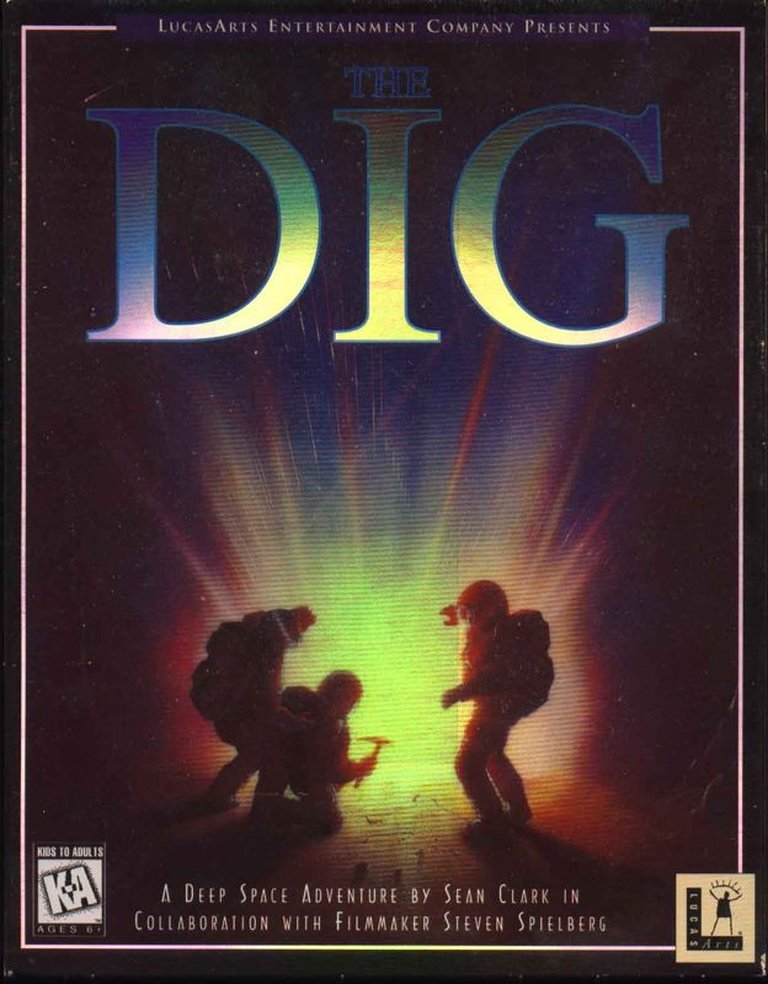- Release Year: 1995
- Platforms: Antstream, DOS, Linux, Macintosh, Windows
- Publisher: Disney Interactive Studios, Inc., LucasArts Entertainment Company LLC, Softgold Computerspiele GmbH
- Developer: LucasArts Entertainment Company LLC
- Genre: Adventure
- Perspective: Side view
- Game Mode: Single-player
- Gameplay: Graphic adventure, Puzzle elements
- Setting: Futuristic, Sci-fi
- Average Score: 61/100

Description
In ‘The Dig,’ a group of scientists led by NASA veteran Boston Low embark on a desperate mission to investigate an asteroid hurtling toward Earth, only to discover an enigmatic alien structure that transports them to a mysterious, seemingly deserted planet. Stranded and cut off from home, the crew—including journalist Maggie Robbins and archaeologist Ludger Brink—must unravel the secrets of an ancient extraterrestrial civilization to survive and find a way back. This point-and-click adventure game from LucasArts blends cinematic storytelling, moody sci-fi atmosphere, and challenging inventory and logic-based puzzles, departing from the studio’s usual comedic tone while retaining subtle humor, all set against hand-drawn environments and a haunting, immersive score. Conceived with input from Steven Spielberg and featuring dialogue by Orson Scott Card, ‘The Dig’ offers a thoughtful, at times poignant exploration of isolation, curiosity, and the unknown.
Gameplay Videos
Where to Buy The Dig
The Dig Free Download
The Dig Mods
The Dig Guides & Walkthroughs
The Dig Reviews & Reception
reddit.com : Overall I’m glad to have revisited and finally closed this chapter of my gaming life, and while it was a touch outdated it’s still quite playable and enjoyable for its 4-6 hour playtime.
gamespot.com (45/100): In almost every sense, The Dig represents a leap backwards from LucasArts’ previous group of adventure games.
imdb.com (80/100): I liked this game quite a bit; the sounds and artwork created the right mood. I even went out and bought the soundtrack CD.
tgbproject.blogspot.com (60/100): Unfortunately, for such a great setup for its story, a big issue with The Dig is that its puzzles are maddening.
The Dig Cheats & Codes
PC
Enter codes during gameplay as specified.
| Code | Effect |
|---|---|
| SWANS | Triggers an animation of a second Boston Low jumping into the water and swimming in the Tram Control room. |
| Control + B | Makes Boston flex his muscles, producing a funny reaction from his teammates. Only works if not in space. |
MS-DOS and Mac OS
Enter codes during gameplay as specified.
| Code | Effect |
|---|---|
| SWANS | Triggers an animation of a second Boston Low jumping into the water and swimming in the Tram Control room. |
| Control + B | Makes Boston flex his muscles, producing a funny reaction from his teammates. Only works if not in space. |
The Dig: Review
Introduction
The Dig is a 1995 point-and-click adventure game by LucasArts that stands as one of the studio’s most ambitious and controversial titles. This review will explore its development history, narrative depth, gameplay mechanics, world-building, reception, and lasting legacy.
Development History & Context
The Dig was originally conceptualized by Steven Spielberg as an episode for his Amazing Stories TV series and later considered as a film. When the film proved too expensive, it evolved into a video game in 1989, starting a development journey spanning six years with multiple project leads (Falstein, Moriarty, Grossman, and ultimately Sean Clark). Originally envisioned with a more violent and adult tone, the game had its darker elements toned down post-Jurassic Park to appeal to a broader audience. This shifting vision contributed to the game’s prolonged development and eventual release in 1995.
Narrative & Thematic Deep Dive
The game’s story follows Commander Boston Low and his team as they investigate an asteroid on a collision course with Earth, only to be transported to a mysterious alien planet. The narrative explores themes of immortality, transcendent dimensions (Spacetime Six), and the hubris of advanced civilizations. Key plot points include the resurrection of characters via life crystals, conflicts over power, and the eventual quest to find a way back to Earth. The story is influenced by classic sci-fi elements, Spielberg’s direction, and Orson Scott Card’s dialogue contributions.
Gameplay Mechanics & Systems
The Dig uses a point-and-click interface with a one-button cursor, differing from earlier LucasArts games. The puzzles are a mix of inventory-based challenges and logical sequences requiring environmental interaction. Notably complex puzzles include assembling a turtle skeleton and repairing a magnifying glass, which drew both praise and criticism. The game’s non-linear structure and large explorable areas were innovative but led to some backtracking.
World-Building, Art & Sound
The game’s art combines hand-drawn backgrounds with pre-rendered 3D elements, creating a vivid alien world. The Separator-style architecture and strange creatures contribute to the atmosphere. The soundtrack by Michael Land features a grand Wagnerian score that evokes the epic nature of the story. The voice acting, led by Robert Patrick, brings the characters to life with performances that are mostly competent.
Reception & Legacy
Upon release, The Dig received mixed reviews. Critics praised its atmosphere, music, and story but criticized puzzle difficulty, graphics, and some dialogue. Commercially, it underperformed expectations. Over time, the game has developed a cult following, with some viewing it as a misunderstood classic. Its influence can be seen in later adventure games, particularly those blending sci-fi with atmospheric storytelling.
Conclusion
The Dig is a unique entry in the LucasArts adventure pantheon, marked by its ambitious storytelling, immersive world, and challenging gameplay. While it may not be suited for casual gamers or those expecting traditional LucasArts humor, it remains a compelling experience for sci-fi enthusiasts and fans of atmospheric adventures. Its legacy showcase how even projects with tumultuous development can yield memorable results.
This review integrates insights from multiple sources including MobyGames, Wikipedia, player reviews, and critical assessments. The Dig’s blend of Spielbergian sci-fi and LucasArts adventure sensibilities creates a distinctive game that continues to spark discussion and appreciation.